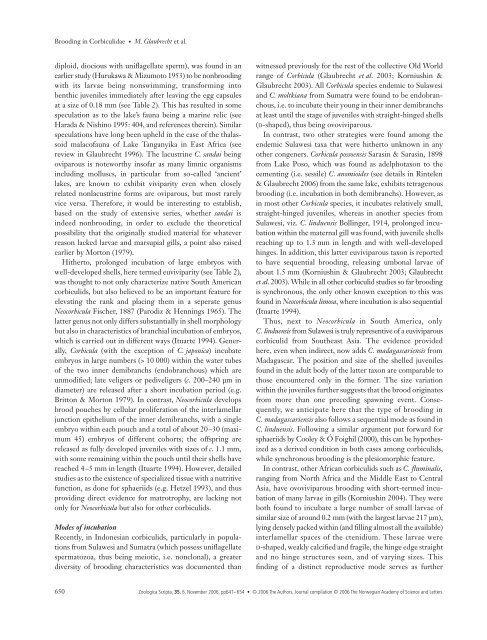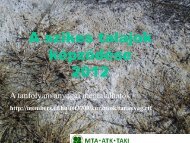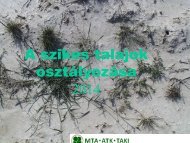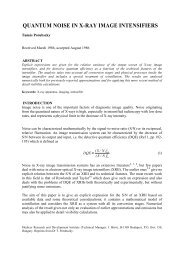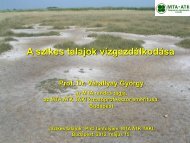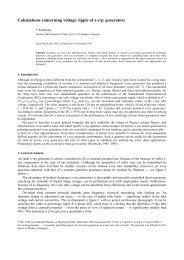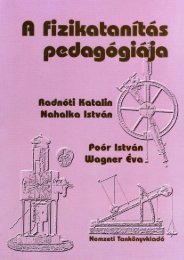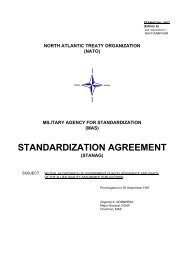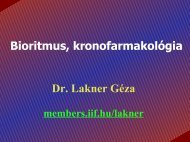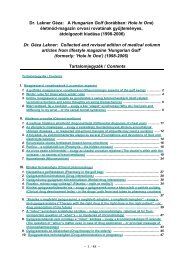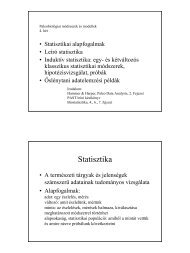Brooding in Corbicula madagascariensis (Bivalvia, Corbiculidae)
Brooding in Corbicula madagascariensis (Bivalvia, Corbiculidae)
Brooding in Corbicula madagascariensis (Bivalvia, Corbiculidae)
- No tags were found...
You also want an ePaper? Increase the reach of your titles
YUMPU automatically turns print PDFs into web optimized ePapers that Google loves.
<strong>Brood<strong>in</strong>g</strong> <strong>in</strong> <strong>Corbiculidae</strong> • M. Glaubrecht et al.diploid, diocious with uniflagellate sperm), was found <strong>in</strong> anearlier study (Hurukawa & Mizumoto 1953) to be nonbrood<strong>in</strong>gwith its larvae be<strong>in</strong>g nonswimm<strong>in</strong>g, transform<strong>in</strong>g <strong>in</strong>tobenthic juveniles immediately after leav<strong>in</strong>g the egg capsulesat a size of 0.18 mm (see Table 2). This has resulted <strong>in</strong> somespeculation as to the lake’s fauna be<strong>in</strong>g a mar<strong>in</strong>e relic (seeHarada & Nish<strong>in</strong>o 1995: 404, and references there<strong>in</strong>). Similarspeculations have long been upheld <strong>in</strong> the case of the thalassoidmalacofauna of Lake Tanganyika <strong>in</strong> East Africa (seereview <strong>in</strong> Glaubrecht 1996). The lacustr<strong>in</strong>e C. sandai be<strong>in</strong>goviparous is noteworthy <strong>in</strong>sofar as many limnic organisms<strong>in</strong>clud<strong>in</strong>g molluscs, <strong>in</strong> particular from so-called ‘ancient’lakes, are known to exhibit viviparity even when closelyrelated nonlacustr<strong>in</strong>e forms are oviparous, but most rarelyvice versa. Therefore, it would be <strong>in</strong>terest<strong>in</strong>g to establish,based on the study of extensive series, whether sandai is<strong>in</strong>deed nonbrood<strong>in</strong>g, <strong>in</strong> order to exclude the theoreticalpossibility that the orig<strong>in</strong>ally studied material for whateverreason lacked larvae and marsupial gills, a po<strong>in</strong>t also raisedearlier by Morton (1979).Hitherto, prolonged <strong>in</strong>cubation of large embryos withwell-developed shells, here termed euviviparity (see Table 2),was thought to not only characterize native South Americancorbiculids, but also believed to be an important feature forelevat<strong>in</strong>g the rank and plac<strong>in</strong>g them <strong>in</strong> a seperate genusNeocorbicula Fischer, 1887 (Parodiz & Henn<strong>in</strong>gs 1965). Thelatter genus not only differs substantially <strong>in</strong> shell morphologybut also <strong>in</strong> characteristics of branchial <strong>in</strong>cubation of embryos,which is carried out <strong>in</strong> different ways (Ituarte 1994). Generally,<strong>Corbicula</strong> (with the exception of C. japonica) <strong>in</strong>cubateembryos <strong>in</strong> large numbers (> 10 000) with<strong>in</strong> the water tubesof the two <strong>in</strong>ner demibranchs (endobranchous) which areunmodified; late veligers or pediveligers (c. 200–240 µm <strong>in</strong>diameter) are released after a short <strong>in</strong>cubation period (e.g.Britton & Morton 1979). In contrast, Neocorbicula developsbrood pouches by cellular proliferation of the <strong>in</strong>terlamellarjunction epithelium of the <strong>in</strong>ner demibranchs, with a s<strong>in</strong>gleembryo with<strong>in</strong> each pouch and a total of about 20–30 (maximum45) embryos of different cohorts; the offspr<strong>in</strong>g arereleased as fully developed juveniles with sizes of c. 1.1 mm,with some rema<strong>in</strong><strong>in</strong>g with<strong>in</strong> the pouch until their shells havereached 4–5 mm <strong>in</strong> length (Ituarte 1994). However, detailedstudies as to the existence of specialized tissue with a nutritivefunction, as done for sphaeriids (e.g. Hetzel 1993), and thusprovid<strong>in</strong>g direct evidence for matrotrophy, are lack<strong>in</strong>g notonly for Neocorbicula but also for other corbiculids.Modes of <strong>in</strong>cubationRecently, <strong>in</strong> Indonesian corbiculids, particularly <strong>in</strong> populationsfrom Sulawesi and Sumatra (which possess uniflagellatespermatozoa, thus be<strong>in</strong>g meiotic, i.e. nonclonal), a greaterdiversity of brood<strong>in</strong>g characteristics was documented thanwitnessed previously for the rest of the collective Old Worldrange of <strong>Corbicula</strong> (Glaubrecht et al. 2003; Korniush<strong>in</strong> &Glaubrecht 2003). All <strong>Corbicula</strong> species endemic to Sulawesiand C. moltkiana from Sumatra were found to be endobranchous,i.e. to <strong>in</strong>cubate their young <strong>in</strong> their <strong>in</strong>ner demibranchsat least until the stage of juveniles with straight-h<strong>in</strong>ged shells(D-shaped), thus be<strong>in</strong>g ovoviviparous.In contrast, two other strategies were found among theendemic Sulawesi taxa that were hitherto unknown <strong>in</strong> anyother congeners. <strong>Corbicula</strong> possoensis Saras<strong>in</strong> & Saras<strong>in</strong>, 1898from Lake Poso, which was found as adelphotaxon to thecement<strong>in</strong>g (i.e. sessile) C. anomioides (see details <strong>in</strong> R<strong>in</strong>telen& Glaubrecht 2006) from the same lake, exhibits tetragenousbrood<strong>in</strong>g (i.e. <strong>in</strong>cubation <strong>in</strong> both demibranchs). However, as<strong>in</strong> most other <strong>Corbicula</strong> species, it <strong>in</strong>cubates relatively small,straight-h<strong>in</strong>ged juveniles, whereas <strong>in</strong> another species fromSulawesi, viz. C. l<strong>in</strong>duensis Boll<strong>in</strong>ger, 1914, prolonged <strong>in</strong>cubationwith<strong>in</strong> the maternal gill was found, with juvenile shellsreach<strong>in</strong>g up to 1.3 mm <strong>in</strong> length and with well-developedh<strong>in</strong>ges. In addition, this latter euviviparous taxon is reportedto have sequential brood<strong>in</strong>g, releas<strong>in</strong>g umbonal larvae ofabout 1.5 mm (Korniush<strong>in</strong> & Glaubrecht 2003; Glaubrechtet al. 2003). While <strong>in</strong> all other corbiculid studies so far brood<strong>in</strong>gis synchronous, the only other known exception to this wasfound <strong>in</strong> Neocorbicula limosa, where <strong>in</strong>cubation is also sequential(Ituarte 1994).Thus, next to Neocorbicula <strong>in</strong> South America, onlyC. l<strong>in</strong>duensis from Sulawesi is truly representive of a euviviparouscorbiculid from Southeast Asia. The evidence providedhere, even when <strong>in</strong>direct, now adds C. <strong>madagascariensis</strong> fromMadagascar. The position and size of the shelled juvenilesfound <strong>in</strong> the adult body of the latter taxon are comparable tothose encountered only <strong>in</strong> the former. The size variationwith<strong>in</strong> the juveniles further suggests that the brood orig<strong>in</strong>atesfrom more than one preced<strong>in</strong>g spawn<strong>in</strong>g event. Consequently,we anticipate here that the type of brood<strong>in</strong>g <strong>in</strong>C. <strong>madagascariensis</strong> also follows a sequential mode as found <strong>in</strong>C. l<strong>in</strong>duensis. Follow<strong>in</strong>g a similar argument put forward forsphaeriids by Cooley & Ó Foighil (2000), this can be hypothesizedas a derived condition <strong>in</strong> both cases among corbiculids,while synchronous brood<strong>in</strong>g is the plesiomorphic feature.In contrast, other African corbiculids such as C. flum<strong>in</strong>alis,rang<strong>in</strong>g from North Africa and the Middle East to CentralAsia, have ovoviviparous brood<strong>in</strong>g with short-termed <strong>in</strong>cubationof many larvae <strong>in</strong> gills (Korniush<strong>in</strong> 2004). They wereboth found to <strong>in</strong>cubate a large number of small larvae ofsimilar size of around 0.2 mm (with the largest larvae 217 µm),ly<strong>in</strong>g densely packed with<strong>in</strong> (and fill<strong>in</strong>g almost all the available)<strong>in</strong>terlamellar spaces of the ctenidium. These larvae wereD-shaped, weakly calcified and fragile, the h<strong>in</strong>ge edge straightand no h<strong>in</strong>ge structures seen, and of vary<strong>in</strong>g sizes. Thisf<strong>in</strong>d<strong>in</strong>g of a dist<strong>in</strong>ct reproductive mode serves as further650 Zoologica Scripta, 35, 6, November 2006, pp641–654 • © 2006 The Authors. Journal compilation © 2006 The Norwegian Academy of Science and Letters


